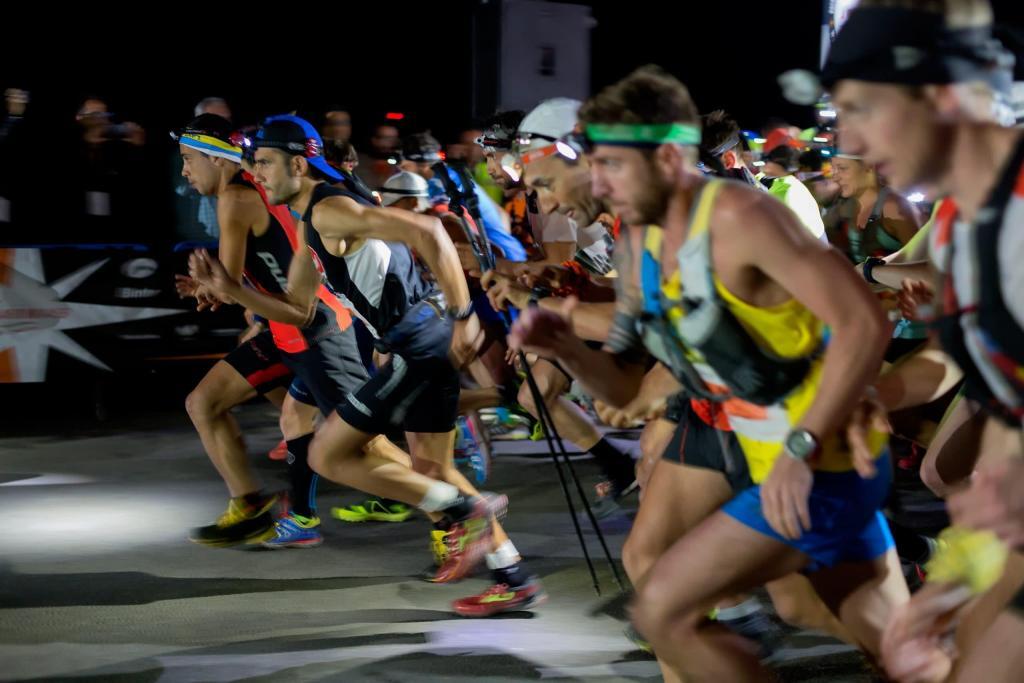Endurance training and racing impacts the gut in many different ways. Learn how it is impacted and what may be done to minimize various types of GI issues.

You’ve probably seen the commercials with someone having a bad case of indigestion and dropping a few white tablets in a glass of water to create a magical, fizzy concoction that is supposed to alleviate the bloat and stomach issues … or the goopy, pink soup-like drink that helps with similar multiple stomach ailments. While these medicines may provide temporary relief, the reality is that the gastrointestinal (GI) distress can sideline you in normal day-to-day life events, as well as during training and racing. In this blog, we will touch upon a small component of the cog in the wheel and break down what GI distress is, causes and symptoms, general nutrition guidelines, and what you can do to minimize the chance for GI distress in ultramarathons.
The information provided in this post regarding GI distress and fueling guidelines will be geared to longer running based events like ultramarathon distance run races which is anything over 26.2 miles (42.2k). Keep in mind these are mostly summary points from the UESCA Ultrarunning Coach Certification – you must determine what works best for you on an individual basis.
What Is GI Distress?
GI Distress is essentially anything that impacts your gut health negatively, whether acute or chronic. Acute GI distress can be as simple as poor nutrition or timing of meals relative to activity. More extreme and/or chronic GI Issues such are, but not limited to autoimmune diseases such as Celiac, Colitis, Crohn’s Disease, Diabetes, and, Irritable Bowel Syndrome (IBS).
Gastrointestinal (GI) distress is a common issue faced by ultramarathon athletes. Symptoms include nausea, vomiting, abdominal cramping, and diarrhea, and have been reported in 37-75% of runners participating in events of 67-161km. Nausea and vomiting are reported as two of the main reasons for dropping out or affecting performance in an ultramarathon.
The underlying cause of GI symptoms in ultrarunners is not fully understood, but contributing factors include the mechanical stress and jostling specific to running, a reduction in splanchnic blood flow, decreased gastric emptying and intestinal absorption, and dehydration. Because the energetic demands are so high, ultramarathon runners must continuously ingest fluid and fuel throughout an event. Too low of fluid intake can lead to dehydration, increasing GI symptoms, while overconsumption of fluid may result in nausea associated with hyponatremia. Exercise-associated hyponatremia is defined as blood sodium levels <135mmol/L (below reference range) and is associated with nausea, GI complaints, confusion, and can be fatal. Similarly, low carbohydrate intake may result in hypoglycemia and nausea, while highly concentrated carbohydrate sources can delay gastric emptying, leading to nausea, vomiting, cramping, and diarrhea. Thus, there is an optimal balance of fluid and fuel consumption to provide adequate energy while avoiding GI distress. This is why it’s recommended to practice strategies in training under various environmental conditions.
Causes of GI Distress can be caused by multiple issues including type and quantity of food consumed, food allergies, hydration status, medication or supplements, duration and intensity of exercise, stress levels, and more.
What’s The Big Deal?

The gastrointestinal system plays a central role in our immune system. There are a huge number of immune cells that live within our gut and give us 70% of our immunity. There is also an intricate balance of good and bad bacteria that give us a healthy immune system.
The gastrointestinal system is the main route of contact with the external environment and is overloaded every day with things that may be harmful, like bacterial/viral/fungal pathogens, toxic substances, unhealthy diets, and medications. Furthermore, our gastrointestinal health is intricately connected to our mental health and our perception of stress. All of these things therefore affect the healthy bacteria, or microbes, that live in our gut, as well as affecting the immune cells. When these get out of balance, we get out of balance and begin down the road of poor health. The longer the symptoms and their root causes go untreated, the worse it is for our immune system and we can develop more substantial medical problems, including autoimmune diseases.
Nutrition Strategies to Train the Gut
On a macro-level breakdown, endurance athletes should be looking to consume ~50-65% of total energy from carbohydrate (CHO), 20-35% from fat, and 15-20% from protein. The big takeaway on nutrition is that each athletes’ requirements will vary and should be practiced and documented in training for optimal performance come race day situations.
Of the aforementioned strategies, below are two strategies of particular importance that coaches should take the time to develop with their athletes.
- Simulating the race nutrition plan. Athletes should go through several test runs of their nutrition strategy during the long runs leading up to their key race, with particular attention being focused on the caloric and fluid rates that will be required in competition. Performing these test runs at least six times before a key competition is recommended.
- Training with larger volumes of fluid and higher CHO rates than what will be necessary during the race. Recent research has suggested that by training with CHO intakes of 90 g/hour in a 2-hour run daily for 2 weeks is enough to improve CHO absorption and gastrointestinal systems in runners (Miall 2018). While this specific protocol (2 hour runs daily for two weeks) is likely not practical from a training perspective, it demonstrates that consistent, high CHO training for several sessions is enough to produce adaptations. The exact dose/response relationship between high CHO gut training is not presently known. However, it is reasonable to assume that consuming CHO at a rate 20-40% higher than what one expects to have in an ultra, for several sessions within two weeks would be enough to show some benefit (for example 2 times per week for 2 weeks in the final 4 weeks leading up to an ultra).
Creating Your Race Day Fueling Strategy

The key to having a successful race day is like anything else … have a plan. This is vital with regards to your nutrition approach. Here is a summary of things to focus on for your race day strategy.
What To Do If GI Distress Occurs During Your Race
Even with the best preparation and strategies, situations like cramping, dehydration, and other can occur. Ideally during your physical and mental training leading to the event, you’ve prepared and rehearsed a back-up plan. Things that you can do during a race include:
- Adjusting your water and electrolyte intake. If you feel constant cramping in your stomach, you may need to increase your water/electrolyte intake. Start slow (4-6oz) and decrease your pace until you feel your stomach settling.
- On your next scheduled fueling (i.e., calories whether liquid or solid) consider decreasing the number of calories consumed. This may only be a marginal amount, but should allow you to get enough calories to continue your pace while letting your digestive system the opportunity to reduce its work requirements. You should not completely eliminate your fuel as your body needs the CHO and fat to continue on in the race. Consider decreasing your intake by 10-30% to when your gut feels better.
- Port-a-potty anyone? The simple act of eliminating may help you feel better and continue on your way. While human nature is not always predictable, bathroom breaks may also be something you want to factor in your training along with your fueling strategies.
- Try to cool down the body. Use water, ice towels (if available), or run in shaded areas if available.
- Switch to a run/walk strategy. While you may not complete the race in your desired time with this effort, this can often help with reducing GI distress by decreasing the intensity placed on the digestive system.
- Increase caloric intake back to the ~250 kcal range (more for bigger athletes) once GI distress has been reduced and you feel ready to resume prior intensity levels.
Summary
The old adage of “Nothing new on race day” cannot be emphasized enough when it comes down to fueling strategies during race day. Implementing that along with the other tips below can be useful to achieving a successful event with minimal or no GI distress.
_________________________________________________________________________
Sean Begley is a contributor and advisor to United Endurance Sports Coaching Academy (UESCA), a science-based endurance sports education company. UESCA educates and certifies running, ultrarunning and triathlon coaches (cycling coming soon!) worldwide on a 100% online platform.








